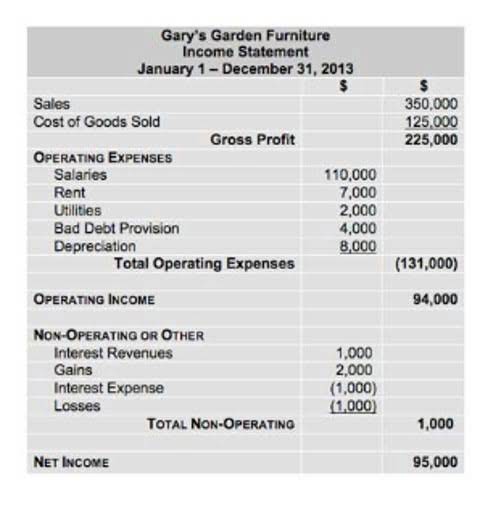Journal Entry for Retained Earnings

This placement highlights its role as a claim on the company’s assets by its owners, derived from reinvested profits. The expense accounts have debit balances so to get rid of their balances we will do the opposite or credit the accounts. Just like in step 1, we will use Income Summary as the offset account but this time we will debit income summary. The total debit to income summary should match total expenses from the income statement. Retained earnings represent the accumulated profits a business has generated over its lifetime that have not been distributed to its shareholders. This account is a significant component of a company’s equity, reflecting the portion of earnings reinvested back into the business or held for future use.
Cash Flow Statement

A company’s shareholder equity is calculated by subtracting total liabilities from its total assets. Shareholder equity represents the amount left over for shareholders if a company pays off all of its liabilities. To see how retained earnings impact shareholders’ equity, let’s look at an example. It should be noted that if an account is normally a debit balance it is increased by a debit entry, and if an account is normally a credit balance it is increased by a credit entry. So for example a debit entry to an asset account will increase the asset balance, and a credit entry to a liability account will increase the liability.
Are Retained Earnings a Type of Equity?
We need to do the closing entries to make them match and zero out the temporary accounts. On one hand, high retained earnings could indicate financial strength since it demonstrates a track record of profitability in previous years. On the other hand, it could be indicative of a company that should consider paying more dividends to its shareholders. This, of course, depends on whether the company has been pursuing profitable growth opportunities. Since retained earnings are a part of shareholders’ equity, it is an obligation of the company to pay it back to the owners.
Unit 4: Completion of the Accounting Cycle
Retained earnings could be used to fund an expansion or pay dividends at a later date. Retained earnings are related to net (as opposed to gross) income because they reflect the net income the company has saved over time. Retained earnings are the earnings left over and kept by a company after paying all current obligations and expenses, including dividend payments to shareholders.
Normal Balances of Accounts Chart
It showcases a company’s financial strength and its https://prolificvent.com/what-is-a-retainer-fee-for-a-lawyer-retainer-fee/ capacity to fund future operations, expand, or pay down debt without relying solely on external financing. The balance in this account provides insight into a company’s historical profitability and its ongoing financial management decisions. By understanding retained earnings through the lens of T accounts, businesses can gain valuable insights into their financial position and make informed decisions about capital allocation. Whether it’s reinvesting in growth, paying down debt, or distributing dividends, retained earnings serve as a vital indicator of a company’s financial strength and future prospects. I’ll show the simple accounting steps used to follow the movement of cash and goods & services into and out of a company, with images of the financial statements and credits and debits.
- Such reductions might occur due to losses incurred by the company or distributions made to shareholders.
- This can lead to increased profitability and shareholder value over time.
- Accounts are the bookkeeping or accounting records used to sort and store a company’s transactions.
- This reduction in retained earnings through dividends is an aspect of how companies manage their capital structure and shareholder returns.
- Understanding the impact of common transactions on retained earnings is crucial for both investors and company management.
- While a higher net income generally leads to an increase in retained earnings, companies may choose to distribute more dividends to shareholders to provide immediate returns.
Loss Impact on Retained Earnings
- Profitability and dividend distributions directly affect retained earnings.
- The amount of retained earnings that a corporation may pay as cash dividends may be less than total retained earnings for several contractual or voluntary reasons.
- This is a liability (shareholders’ fund) of the company to pay the earnings back to the shareholders.
- They can reinvest the funds into the business for expansion, research and development, or capital expenditures.
- Here is another summary chart of each account type and the normal balances.
- After the year-end closing, company summary all revenue and expense which can result in loss or profit.
If the balance of retained earnings is negative, then it is referred to as accumulated losses/deficit, or retained losses. By starting each year with zero balances, the income statement accounts will be accumulating and reporting only the company’s revenues, expenses, gains, and losses occurring during the new year. This reduction in retained earnings through dividends is an aspect of how companies manage their capital structure and shareholder returns.

As per the Modern Rules of Accounting
“Retained” refers to the fact that those earnings were kept by the company. Regardless of what elements are present in the business transaction, a journal entry will always have AT least one debit and one credit. You should be able to complete the debit/credit columns of your chart of accounts spreadsheet (click Chart of Accounts). The reasoning behind this rule is that revenues increase retained earnings, and increases in retained earnings are recorded on the right side. Expenses decrease retained earnings, and decreases in retained earnings are recorded on the left side. We will continue this discussion later, but for now take note that a credit entry is required to increase owner’s equity or stockholders’ equity.

An alternative to the statement of retained earnings is Oil And Gas Accounting the statement of stockholders’ equity. Note that a retained earnings appropriation does not reduce either stockholders’ equity or total retained earnings but merely earmarks (restricts) a portion of retained earnings for a specific reason. Yes, retained earnings carry over to the next year if they have not been used up by the company from paying down debt or investing back in the company. Beginning retained earnings are then included on the balance sheet for the following year. Additional paid-in capital is included in shareholder equity and can arise from issuing either preferred stock or common stock.

T accounts are a visual representation of a company’s general ledger accounts, providing a snapshot of the debits and credits affecting a specific account. For 25 years I observed college students struggling with the bookkeeping and accounting terms “debit” and “credit”. They easily memorized that asset accounts should normally have debit balances, and those debit balances will increase with a debit entry and will decrease with a credit entry. They also memorized that liability and owner’s (or stockholders’) equity accounts normally have credit balances that increase with a credit entry and decrease with a debit entry.

Example 2: Declaring Dividends from Retained Earnings
In that case, the T account for retained earnings would reflect an increase, indicating that the company has retained more of its earnings for future use, such as reinvestment the retained earnings account is increased with an entry on the side of the account. or debt repayment. Retained earnings, as the name suggests, refer to the portion of a company’s profits that it chooses to retain rather than distribute to shareholders as dividends. These earnings play a vital role in the financial health and long-term sustainability of a business. From the perspective of business owners, retained earnings represent a valuable source of capital that can be reinvested to fuel growth and expansion.

